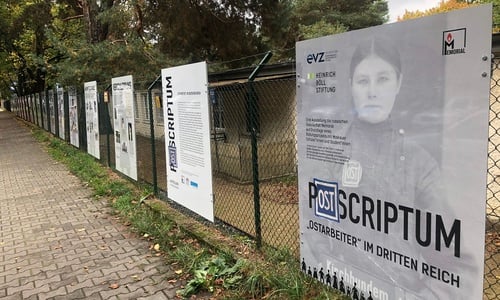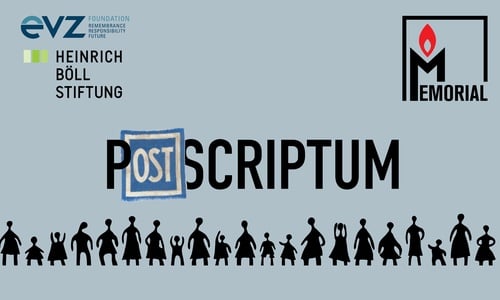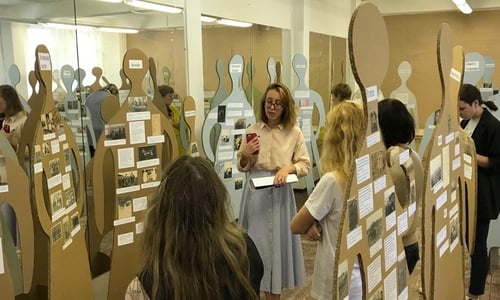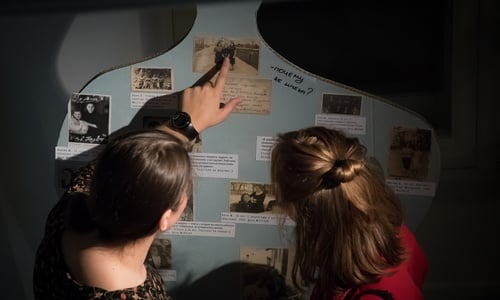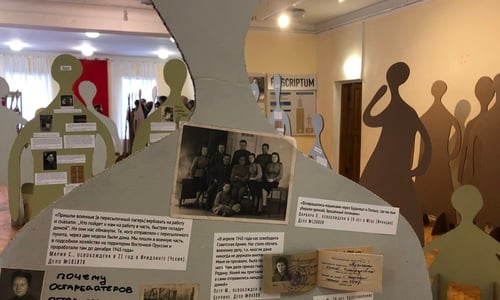base.memo.ru: Victims of political terror in the Soviet Union, a general database
stalin.memo.ru: Stalin's execution lists, 1937–1954
mos.memo.ru: Repression victims executed in Moscow
pkk.memo.ru: Political Red Cross archives, 1918–1922
"Ubity v Katyni": a PDF version of the book containing data on the Polish POWs who were held at an NKVD camp in Kozelsk and fell victims to the Katyn massacre
"Ubity v Kalinine, zakhoroneny v Mednom": a PDF version of the book containing data on the Polish POWs who were held at an NKVD camp in Ostashkov. Book 1 (pdf) Book 2 (pdf) Book 3 (pdf)
histor-ipt-kt.memo.ru: Repression against the True Orthodox (Catacomb) Church members, late 1920s –1970s
cathol.memo.ru: Repression against the Catholic Church members, 1918 – 1980s
Our partners:
openlist.wiki: Open list project
If you wish you could make a monthly donation on donate.memo.ru
Donations are in Russian roubles. Your credit card exchange rates may apply. All credit card information is processed in compliance with Visa International / MasterCard Worldwide requirements. We do not store your credit card details. Encryption is used to transmit your credit card information. If you have any queries, please e-mail to us at [email protected]
Here are the details of our bank account where you could transfer money for donation.
Please indicate the purpose of the transfer as "Private targeted donation to the statutory activities of the organisation".
Could we also ask you to send us a letter (e-mail address: [email protected]) on the name of our Executive Director Elena Zhemkova with the following content:
To the Executive Director of the International Memorial E. Zhemkova
Dear Mrs. Zhemkova,
I am informing you that I’ve made a private donation of the amount of XX on the statutory activities of the International Memorial.
/Your name and surname, date (no later than the date of sending the transfer)/
We will provide this letter to our bank in order to receive the donation.
MEMORIAL INTERNATIONAL
FINANCIAL IDENTIFICATION
Bank information of International public organisation "Memorial International Historical, Educational, Charitable and Human Rights Society".
The short title is Memorial International.
FOR TRANSFER IN US DOLLARS
Beneficiary Bank
SWIFT code SABRRUMM
SBERBANK (HEAD OFFICE – ALL BRANCHES AND OFFICES IN RUSSIA), MOSCOW, RUSSIA
UL.VAVILOVA 19, MOSCOW 117997, RUSSIA
Beneficiary Customer
40703840938040200872
MEMORIAL INTERNATIONAL
MALYI KARETNYI PEREULOK 12, MOSCOW 127051, RUSSIA
Details of Payment
Private target donation for the authorized activities of the organisation
Correspondent Bank
SWIFT code IRVTUS3N
THE BANK OF NEW YORK MELLON, NEW YORK, NY, USA
FOR TRANSFER IN EURO
Beneficiary Bank
SWIFT code SABRRUMM
SBERBANK (HEAD OFFICE – ALL BRANCHES AND OFFICES IN RUSSIA), MOSCOW, RUSSIA
UL.VAVILOVA 19, MOSCOW 117997, RUSSIA
Beneficiary Customer
40703978538040200872
MEMORIAL INTERNATIONAL
MALYI KARETNYI PEREULOK 12, MOSCOW 127051, RUSSIA
Details of Payment
Private target donation for the authorized activities of the organisation
Correspondent Bank
SWIFT code DEUTDEFF
DEUTSCHE BANK AG. FRANKFURT AM MAIN, GERMANY
Договор
о благотворительном пожертвовании
(публичная оферта)
г. Москва 1 апреля 2017 г.
Международная общественная организация «Международное историко-просветительское, благотворительное и правозащитное общество «Мемориал», в лице Исполнительного директора Жемковой Елены Борисовны, действующей на основании Устава, именуемая в дальнейшем «Благополучатель», настоящим предлагает физическим лицам или их представителям, именуемым в дальнейшем «Благотворитель», совместно именуемые «Стороны», заключить Договор о благотворительном пожертвовании на нижеследующих условиях:
1.Общие положения о публичной оферте
1.1. Данное предложение является публичной офертой в соответствии с пунктом 2 статьи 437 Гражданского Кодекса РФ.
1.2. Акцептом настоящей оферты является осуществление Благотворителем перечисления денежных средств на расчётный счёт Благополучателя в качестве благотворительного пожертвования на уставную деятельность Благополучателя. Акцепт данного предложения Благотворителем означает, что последний ознакомился и согласен со всеми условиями настоящего Договора о благотворительном пожертвовании с Благополучателем.
1.3. Оферта вступает в силу со дня, следующего за днём её публикации на официальном сайте Благополучателя www.memo.ru , именуемом в дальнейшем «Сайт».
1.4. Текст настоящей оферты может быть изменен Благополучателем без предварительного уведомления и действует со дня, следующего за днём его размещения на Сайте.
1.5. Оферта действует до дня, следующего за днем размещения на Сайте извещения об отмене Оферты. Благополучатель вправе отменить Оферту в любое время без объяснения причин.
1.6. Недействительность одного или нескольких условий Оферты не влечёт недействительности всех остальных условий Оферты.
1.7. Принимая условия данного соглашения, Благотворитель подтверждает добровольный и безвозмездный характер пожертвования.
2.Предмет договора
2.1. По настоящему договору Благотворитель в качестве благотворительного пожертвования перечисляет собственные денежные средства на расчётный счёт Благополучателя, а Благополучатель принимает пожертвование и использует на уставные цели.
2.2. Выполнение Благотворителем действий по настоящему договору является пожертвование в соответствии со статьей 582 Гражданского кодекса РФ.
3.Деятельность Благополучателя
3.1. Целью деятельности Благополучателя в соответствии с Уставом является::
- содействие в построении развитого гражданского общества и демократического правового государства, исключающего возможность возврата к тоталитаризму;
- формирование общественного сознания на основе ценностей демократии и права, преодоление тоталитарных стереотипов и утверждение прав личности в политической практике и общественной жизни;
- восстановление исторической правды и увековечение памяти жертв политических репрессий тоталитарных режимов;
- выявление, обнародование и критическое осмысление информации о нарушениях прав человека тоталитарными режимами в прошлом и прямых и косвенных последствиях этих нарушений в настоящем;
- содействие полной и гласной моральной и юридической реабилитации лиц, подвергшихся политическим репрессиям, принятию государственных и других мер по возмещению нанесенного им ущерба и предоставлению им необходимых социальных благ.
3.2. Благополучатель в своей деятельности не имеет целью извлечение прибыли и направляет все ресурсы на достижение уставных целей. Бухгалтерская отчетность Благополучателя ежегодно проходит аудиторскую проверку. Благополучатель публикует информацию о своей работе, целях и задачах, мероприятиях и результатах на сайте www.memo.ru и в других открытых источниках.
4. Заключение договора
4.1. Акцептовать Оферту и тем самым заключить с Благополучателем Договор вправе только физическое лицо.
4.2. Датой акцепта Оферты и соответственно датой заключения Договора является дата зачисления денежных средств на банковский счёт Благополучателя. Местом заключения Договора считается город Москва Российской Федерации. В соответствии с пунктом 3 статьи 434 Гражданского кодекса Российской Федерации Договор считается заключенным в письменной форме.
4.3. Условия Договора определяются Офертой в редакции (с учётом изменений и дополнений), действующей (действующих) на день оформления платёжного распоряжения или день внесения им наличных денег в кассу Благополучателя.
5. Внесение пожертвования
5.1. Благотворитель самостоятельно определяет размер суммы благотворительного пожертвования и перечисляет его Благополучателю любым платёжным методом, указанным на сайте www.memo.ru на условиях настоящего Договора.
5.2. При перечислении пожертвования путём оформления списания с банковского счёта в назначении платежа следует указать «Пожертвование на уставную деятельность».
6. Права и обязанности сторон
6.1. Благополучатель обязуется использовать полученные от Благотворителя по настоящему договору денежные средства строго в соответствии с действующим законодательством РФ и в рамках уставной деятельности.
6.2. Благотворитель даёт разрешение на обработку и хранение персональных данных, используемых Благополучателем исключительно для исполнения указанного договора.
6.3. Благополучатель обязуется не раскрывать третьим лицам личную и контактную информацию Благотворителя без его письменного согласия, за исключением случаев требования данной информации государственными органами, имеющими полномочия требовать такую информацию.
6.4. Полученное от Благотворителя пожертвование, по причине закрытия потребности частично или полностью не израсходованное согласно назначению пожертвования, указанному Благотворителем в платежном поручении, не возвращается Благотворителю, а перераспределяется Благополучателем самостоятельно на другие актуальные программы.
6.5. Благополучатель имеет право извещать Благотворителя о текущих программах с помощью электронных, почтовых и СМС-рассылок, а также с помощью телефонных обзвонов.
6.6. По запросу Благотворителя (в виде электронного или обычного письма) Благополучатель обязан предоставить Благотворителю информацию о сделанных Благотворителем пожертвованиях.
6.7. Благополучатель не несет перед Благотворителем иных обязательств, кроме обязательств, указанных в настоящем Договоре.
7.Прочие условия
7.1. В случае возникновения споров и разногласий между Сторонами по настоящему договору, они будут по возможности разрешаться путем переговоров. В случае невозможности разрешения спора путем переговоров, споры и разногласия могут решаться в соответствии с действующим законодательством Российской Федерации в судебных инстанциях по месту нахождения Благополучателя.
8.Реквизиты сторон
БЛАГОПОЛУЧАТЕЛЬ:
Международная общественная организация «Международное историко-просветительское, благотворительное и правозащитное общество «Мемориал»
ИНН: 7707085308
КПП: 770701001
ОГРН: 1027700433771
Адрес:127051, Москва, Малый Каретный переулок, д.12,
Электронный адрес: [email protected]
Банковские реквизиты:
Международный Мемориал
Расчетный счет: 40703810738040100872
Банк: ПАО СБЕРБАНК г.МОСКВА
БИК: 044525225
Корр. счет: 30101810400000000225
Ostarbeiter in the Third Reich
A year after the beginning of digitization of the most valuable part of the collection of the history of forced labor International Memorial staff, volunteers and interns organized an exhibition based on the described and scanned materials. The exhibition was called «Postscriptum» and was opened in one of the Moscow schools.
In 1941 the world war reached the USSR. Only a few months after the German assault huge territories of Ukraine, Belarus, western, north-western and southern parts of Russia were occupied by German and allied troops. With the beginning of occupation a new life started for the residents of these areas. Many of them were forced to leave their houses to work at plants and farms in Germany, Poland and Austria. Workers from the Soviet Union were given a bureaucratic name of «ostarbeiters» in the Third Reich (German «East workers»). Their emblem – the OST identification patch on the breast – became a symbol of humiliation and free labor for the benefit of a hostile state and army.
However, behind the symbols and bureaucratic cliches we find the fates of real people, who grew up, made friends, loved and died in a war-struck Europe. They did not know the language of the country they found themselves in, did not know how the war would end or what would happen to them in a year or two. And upon return to the USSR did not know what to do with their experience. They could only share it with each other, as a person who spent the war at the other side of the front, the non-Soviet side, was considered a traitor.
It lasted for almost 50 years. And then an astonishing thing happened. In response to a newspaper article running that Memorial Society would be dealing with the payment of compensations for free labor in Germany the organization received more than 320 thousand letters in two months. People sent detailed stories of their lives in Germany, personal documents and photos. Thanks to the mistake of the journalist (as of that moment Memorial had nothing to do with compensation payments) a whole generation of victims of forced labor spoke out. Now you can also hear their voices.
Soviet victims of the German forced labor system were able to receive compensations only after the collapse of the Soviet Union. Two waves of compensation payments from the German government and private companies in the 1990s and beginning of 2000s embraced practically all those who could prove their stay in Germany. The letters received by Memorial also played a significant role in that process.
By various estimates from 3,2 to 5 million Ostarbeiter worked in Germany during the war. These people survived the horrors of German occupation and forced deportation, saw a thriving Germany with the eyes of slaves with no rights, witnessed the destruction of cities by Soviet and allied air force, returned to their home country devastated by war as traitors and outcasts. Their story is a story of the horror of war and mass discrimination. And we have yet to reflect upon and understand this story.
The exhibition represents a labyrinth. Its several road forks correspond to global forks in the fate of an ostarbeiter (for instance, finding oneself at production site or in agriculture). According to the «rules» the choice of this or that way excludes a chance to return. Thus we wanted to show that the attitude towards those events to a large extent depends on peripeteia of personal biographies. Studying the photographs, documents and fragments of memoirs sent to Memorial, the visitors answer the questions asked on the display stands and record on special cards a biography of an imaginary ostarbeiter made up from the shatters of hundreds of biographies presented in our archive.
Interviews with authors and the animated film «Ostarbeiter» (directed by Poina Kampioni) produced in the course of an archive internship for school students in International Memorial make an inherent part of the exhibition.
The exhibition is mobile, and the authors will be happy to organize it in regional museums and schools. To organize the exhibition in your city, write to curator Evelina Rudenko – [email protected].
Curators – Nikita Lomakin, Evelina Rudenko.
Authors of the exhibition – Maria Dubovskaya, Sofia Eremina, Elisaveta Novokreschenova, Natalia Rakitina, Lena Reger, Anastasia Sokova, Elisaveta Starikova, Margarita Khakhanova.
Designer – Stas Zhitsky.
Editor – Natalia Altukhova.
The archive was digitized and exhibition organized with the participation of Ilya Alexeev, Natalia Baryshnikova, Nikita Bityutsky, Daria Bogdan, Dmitry Vasiliev, Anna Vasyukova, Ekaterina Gurtovaya, Anna Dzyadko, Kira Zhukovskaya, Mariana Kozlova, Fyodor Morgunov, Sofia Morgunova, Elena Novoselova, Vassily Starostin.
Acknowlegements to Elena Zhemkova (International Memorial), Alyona Kozlova (International Memorial), Irina Ostrovskaya (International Memorial), Irina Scherbakova (International Memorial), Evgeny Kulbatsky (Rastr-Technology), Zhanna Nasupkina (the Book Institute).
The exhibition is implemented with the financial support of the EVZ Foundation and the Enlightener Prize.
© International Memorial, 2018
